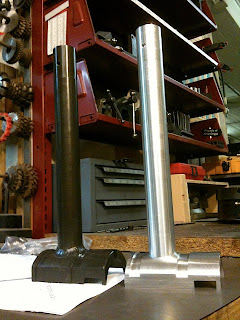
You can see in this picture that the coupling lost a big chunk on the side opposite from the direction of thrust. Basically, it cracked under the force of the thruster alone.
The amount of empty space in this printed part is clear now, and it's an open question whether the failure was related to salt or rust buildup inside these spaces.
Damage Report
Thursday, July 30, 2009
Posted by Ian at 9:41 AM
Labels: damage report, thruster
Against All Odds!
Wednesday, July 29, 2009
 Today was a great day!
Today was a great day!
Two divers helped us find the lost thruster, after 2 weeks of being lost.  We got special permission from the assistant Harbor Master to conduct our search in the middle of the shipping lane.
We got special permission from the assistant Harbor Master to conduct our search in the middle of the shipping lane.
"Please tell me this thing's expensive," he said.
"About $15,000".
He nodded.
The divers searched by taking 2 compass readings and heading out to where the lines crossed. They worked by dropping an anchor with their dive flag, and making concentric circles around it, getting further and further out as they searched in the muck by hand. After a while, they found... nothing. We turned back to the Harbor Master. Since we had a GPS fix of where the vehicle was when it started going in circles, we figured we should use that technology instead to compasses to find the start of the search pattern.
We turned back to the Harbor Master. Since we had a GPS fix of where the vehicle was when it started going in circles, we figured we should use that technology instead to compasses to find the start of the search pattern.
"Let us do just one more try, and if this doesn't work we'll give up for good".
He said OK.
As it turned out, the new center of the search pattern was pretty far from where the compass readings had put it.  So the diver started again. It seemed like they were down for much longer on the second search, and we realized that we had probably missed again.
So the diver started again. It seemed like they were down for much longer on the second search, and we realized that we had probably missed again.
But when they came back up, they had a thruster raised above their heads! SUCCESS! They had found it on the next-to-last circle that they planned to make, and it was buried under 6 inches of sediment. The diver had been pawing through the muck, and hit something solid: OUR THRUSTER!
Take a good look at these guys, they are heroes!
Finished the New Thruster Arm
Thursday, July 23, 2009



 ZAP, CRACKLE
ZAP, CRACKLE
Posted by Ian at 3:16 PM
Labels: fabrication, thruster, welding
Thruster Arm Progress
Wednesday, July 22, 2009
Posted by Ian at 8:02 PM
Labels: fabrication, lathe, mill, thruster
Plan B: A New Thruster
Tuesday, July 21, 2009

Since this is fairly simple fabrication, it is far faster and cheaper for us to do the machining ourselves at a local shop.
Posted by Ian at 4:34 PM
Labels: fabrication, lathe, plan b, thruster
An Unsuccessful Search
Wednesday, July 15, 2009


Disaster Strikes!
Tuesday, July 14, 2009
Our 3-D printed mechanical fuse for the RTU coupling cracked and broke, taking our thruster to the bottom of Gloucester harbor.
Justin: Mike, the vehicle is going in circles instead of forward. Can you check the connection to the thruster?
Mike: Sure.
(Pause)
Mike: What thruster?
It would have ordinarily been retained by the electrical cable but ... we had just set it up to unplug rather than put strain on the other cable. "Whoops" doesn't quite capture the disappointment.
Posted by Ian at 8:10 PM
Labels: disaster, failure, more deployments than recoveries
Bypassing Sliprings
Friday, July 10, 2009
Of all the users of Parker DriveBloks, we seem to be the only ones that experience frequent capacitor failures. Of the failures we have, only the thrusters that go through the RTU (and its sliprings) seem to suffer.
Solution: bypass the sliprings by drilling a hole in the fairing for the cable. As a safety precaution against continuous rotation of the RTU (disabled in software, but... you never know), we aren't using the plastic shells to hold the cables together.
There's Your Problem...
Thursday, July 9, 2009

Since this was largely the result of wires and plugs being crowded near the top of the bottle, I drilled a hole in the mounting plate for the PC boards and routed some of the wires to the back side.


